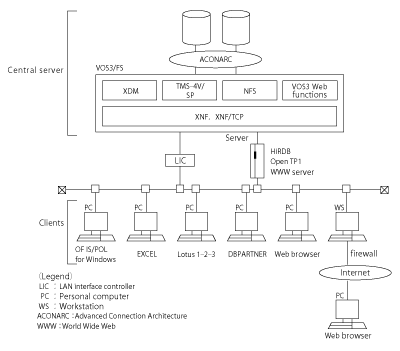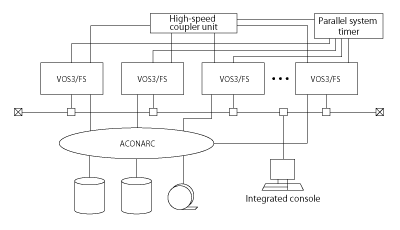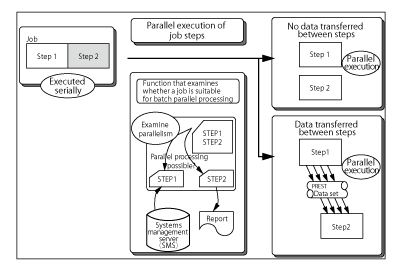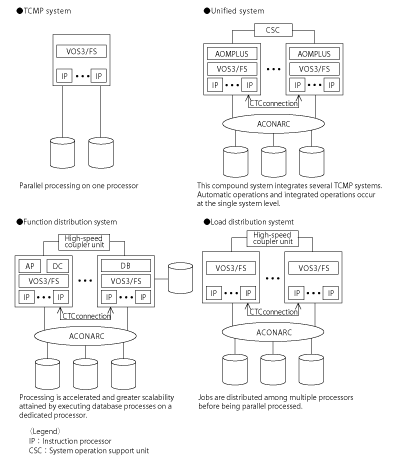VOS3/FS was developed as an upgraded operating system over VOS3/AS, which supported the MP5800, which was the world’s fastest single-processor machine in 1995, and its smaller sister models, including the MP5500. VOS3/FS offered improved performance, improved reliability, and improved scalability with a suite of extensive parallel functions, including parallel batch processing and parallel database processing. The new operating system enabled a single platform to support all kinds of applications and services, from services needing the power of a massive single-processor machine to services that benefit from the speed and reliability gains delivered from parallel processing with multiple relatively small processor
Hitachi announced VOS3/FS in April 1995 and began shipping the operating system in October the same year.
VOS3/FS was developed to be a total management server system. A total management server system single-handedly took on the roles of database server, management server, and computing server while acting as a system server at the core of a wide complex system consisting of networks, personal computers, workstations, and departmental servers. To create such a wide complex system, Hitachi devised the Hitachi Application Architecture (HAA), which, as a highly scalable architecture, offered a common application development and usage environment. HAA improved connectivity with open systems and enabled the construction of large-scale systems with its rich set of functions.
As an architecture providing a common application development and usage environment, HAA had the following three common interfaces.
| Interface |
Description |
| Application programming interface (API) |
A common programming interface for systems forming a wide complex system |
| Inter-application communication support interface (CSI) |
A common communication interface for applications in different systems to communicate with each other |
| Common operation interface (COI) |
A common operation interface for different terminals and workstations |
HAA also made it possible to build the following kinds of system environments to bolster connectivity with open systems.
- Environments in which personal computers and workstations can access assets on the central system
- Environments in which personal computers and workstations are coupled in a coordinated fashion with the central system for distributed processing
- Environments in which personal computers, workstations, and the host computer are integrally managed as one system
 Figure 1: Examples of connectivity with open systems
Figure 1: Examples of connectivity with open systemsFor the construction of large-scale systems, HAA supplied the following functions.
- Functions for parallel execution on high-performance hardware
- Support for large storage units and expansion storage units
- Large databases and data centers
- Enhanced networking
- Remote batch functions — remote job entry (RJE) and remote branch station program (RESP
VOS3/FS implemented parallel execution features to accelerate processing speeds. Figure 2 gives an overview of the parallel execution system.
 Figure 2: Overview of a parallel execution system
Figure 2: Overview of a parallel execution system The following hardware functions were supplied to implement the parallel execution system.
- Advanced connection architecture (ACONARC) for flexibly connecting to and operating peripheral devices
- High-speed coupler unit for controlling at high speeds parallel processing among multiple processors
- Integrated console for operating and managing the entire system
- Parallel system timer to synchronize multiple processors
VOS3/FS provided the following parallel execution functions.
- (1)Function for parallel execution of database processes
- This function aimed to reduce the processing times for large-scale database systems by executing input and output processes in parallel and distributing and parallel executing queries. It also distributed the loading on processors by executing database processes on a dedicated database processor.
- (2)Function for parallel execution of job steps
- This function aimed to reduce the execution time of jobs with multiple job steps by executing the job steps in parallel. It also allowed one job step to simultaneously transfer in memory data to multiple subsequent job steps and to distribute data among multiple subsequent job steps. Figure 3 illustrates the parallel execution of job steps.
 Figure 3: Function for parallel execution of job steps
Figure 3: Function for parallel execution of job steps- (3)Function for parallel execution of transactions
- When making a session connection, this function automatically selected the system to handle the connection according to the loads on each online system. This function allowed multiple networked systems to be handled as one system. The transaction execution time was reduced once the session was established by simultaneously executing the same transaction on multiple systems from any terminal
VOS3/FS provided the flexibility to construct various types of parallel execution systems to suit its use configuration. For example, functions could be assigned to specific processors, jobs could be divided up among multiple processors, or system loads could be distributed. VOS3/FS offered substantial scalability by making it easy to migrate from a TCMP-type system, where parallel functions only existed within a processor, to systems where parallel functions could be used between processors. Figure 4 illustrates some parallel execution system configurations.
 Figure 4: Examples of parallel execution system configurations
Figure 4: Examples of parallel execution system configurations As forms of large storage unit support, VOS3/FS provided each user with 2 GB (2,048 MB) of multiple virtual storage as well as providing an M/ASA mode that used large-volume storage units. The M/ASA mode made it possible to process large amounts of data at high speed in memory by making use of large amounts of installed memory. The mode consisted of the following functions.
- Data space: Space reserved for data separate from the address space was created so that large amounts of data could be placed in virtual memory.
- Extended addressing: It was possible to address 16 terabytes by using the data space.
The extended storage function supported high-speed internal extended storage units with large storage capacities to accelerate data processing. The extended storage function had the following four applications.
- High-speed auxiliary storage for paging and swapping
- Extended storage (ES) file function: a function that allocates and uses sequential access method (SAM) files in an extended storage unit)
- ES resident database function (XDM/SD): a function that keeps frequently accessed databases in ES
- Using the extended storage unit as an RD area for XDM/RD work
Using virtual memory, VOS3/FS provided the following functions to accelerate the processing of large amounts of data in memory.
- Data in virtual (DIV): a function that mapped virtual storage access memory (VSAM) data sets in virtual memory to manipulate data without using I/O macro instructions
- Extended program loading (XPL): a function that sped up processing by preloading a program in virtual memory and then copying it directly from virtual memory when a load instruction was made
- VSAM high-performance access facility (HAF): a function that keeps part of a VSAM data set in virtual memory to reduce the number of I/O cycles and speed up processing
- Parallel reference and synchronous transfer (PREST): a function that accelerates I/O processes by performing the input and output of temporary data between jobs or between job steps entirely in main memory





